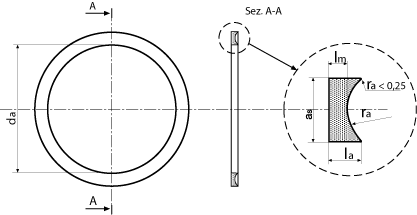Characteristics of the anti extrusion rings
The anti-extrusion rings (figure 6.4) are designed and realised in a way to guarantee a high level of seal performance in contact with the O-Ring. The curves that present on the support side, the accurate choice of the hardness grade of the mix and the characteristic of being made in single pieces, without gaskets, guarantee the absence of elements which can damage the O-Ring.
 Figure 6.4
Figure 6.4Anti-extrusion ring
The compounds chosen for the realisation of the anti-extrusion rings must meet all of the compatibility requests of the fluids requested of the O-Rings, but present increased hardness to support the other pressure loads; they must in addition be very resistant to the usage and ageing, to guarantee good performance for the entire life of the O-Ring to which they are required to protect.
The main mix used for the realisation of our anti-extrusion rings is a nitrile butadiene (NBR), to which particular elements are added that improve its behaviour at temperature. The code of this mix is ME0073/90 with a hardness of 90° shore. This mix presents all of the characteristics of the NBR mix, including the compatibility with many fluids used usually in hydraulic and pneumatic circuits, to this characteristic, the good behaviour is added giving a more ample temperature spectrum: from –55°C to 105°C.
In the standard production Elastotech, also anti-extrusion rings in other compounds are present, the ME0182/90 and the ME0270/90, to meet the requirements of different application sectors.
An important factor that improves the performance of the O-Rings with the anti-extrusion rings is linked to the absorbent of a small quantity of lubricant from part of the ring mix; these small quantities of lubricant contribute to maintaining the O-Ring lubricated, increasing the seal capacity and its life.
The economic advantage that is achieved by using the anti-extrusion rings is not only linked to the increased life of the O-Ring, but also to the simplification of the working for the realisation of the seal housing: their positioning avoids the direct contact between the O-Ring and the housing walls, which can therefore present inferior finishing levels with respect to those required in case of direct contact with the gasket.
The main mix used for the realisation of our anti-extrusion rings is a nitrile butadiene (NBR), to which particular elements are added that improve its behaviour at temperature. The code of this mix is ME0073/90 with a hardness of 90° shore. This mix presents all of the characteristics of the NBR mix, including the compatibility with many fluids used usually in hydraulic and pneumatic circuits, to this characteristic, the good behaviour is added giving a more ample temperature spectrum: from –55°C to 105°C.
In the standard production Elastotech, also anti-extrusion rings in other compounds are present, the ME0182/90 and the ME0270/90, to meet the requirements of different application sectors.
An important factor that improves the performance of the O-Rings with the anti-extrusion rings is linked to the absorbent of a small quantity of lubricant from part of the ring mix; these small quantities of lubricant contribute to maintaining the O-Ring lubricated, increasing the seal capacity and its life.
The economic advantage that is achieved by using the anti-extrusion rings is not only linked to the increased life of the O-Ring, but also to the simplification of the working for the realisation of the seal housing: their positioning avoids the direct contact between the O-Ring and the housing walls, which can therefore present inferior finishing levels with respect to those required in case of direct contact with the gasket.
